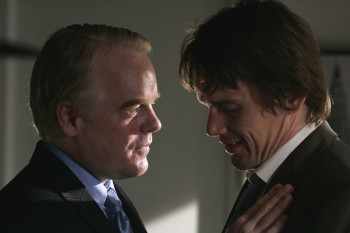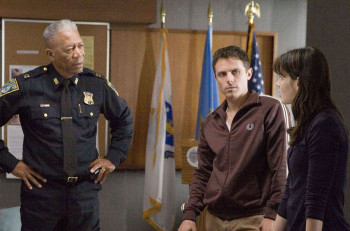Twitter Review: Stay
2005’s ‘Stay’ is too aggressively off, fostering sensitivity to its head game rather than engagement in the story. Gosling holds it together
2005’s ‘Stay’ is too aggressively off, fostering sensitivity to its head game rather than engagement in the story. Gosling holds it together
Aussie crime thriller ‘The Square’ is poised to explore guilt in a handful of characters but instead becomes a ridiculous, contrived tragedy
 While I still don’t really understand the Twitter phenomenon, I’ve loved using the 140-character limit for extreme forced concision. The aim is always to pack these ridiculously short reviews with enough meaning that I don’t feel guilty about never writing more about a particular movie or television show. I would never say that 140 characters is sufficient to discuss much of anything – let alone a feature film – but it’s a great if arbitrary writing exercise: How much can you say within Twitter’s confines? For the most part, I’ve been happy with the results. But with Tell No One, I feel that I need to explain myself.
While I still don’t really understand the Twitter phenomenon, I’ve loved using the 140-character limit for extreme forced concision. The aim is always to pack these ridiculously short reviews with enough meaning that I don’t feel guilty about never writing more about a particular movie or television show. I would never say that 140 characters is sufficient to discuss much of anything – let alone a feature film – but it’s a great if arbitrary writing exercise: How much can you say within Twitter’s confines? For the most part, I’ve been happy with the results. But with Tell No One, I feel that I need to explain myself.
Teasing with odd, existential potential, the tight French thriller ‘Tell No One’ sadly picks a worn, logical path. A lovely ending, though.
 Memento is such a triumph of tricky narrative structure that it’s difficult to get (and keep) a grip on what happens, let alone the objective truth of its protagonist’s past. Christopher Nolan’s second feature, which he wrote and directed based on his brother Jonathan’s short story, seems perpetually slippery and elusive. I’ve seen it at least six times since it was released in the U.S. in 2001 (it debuted at festivals in September 2000), and even though I know it well, each time it repeatedly throws me off. The movie’s closing line – in context, a sick joke by Nolan – is an excellent summary of how I feel watching it: “Now … where was I?”
Memento is such a triumph of tricky narrative structure that it’s difficult to get (and keep) a grip on what happens, let alone the objective truth of its protagonist’s past. Christopher Nolan’s second feature, which he wrote and directed based on his brother Jonathan’s short story, seems perpetually slippery and elusive. I’ve seen it at least six times since it was released in the U.S. in 2001 (it debuted at festivals in September 2000), and even though I know it well, each time it repeatedly throws me off. The movie’s closing line – in context, a sick joke by Nolan – is an excellent summary of how I feel watching it: “Now … where was I?”
‘Quantum of Solace’: Uniformly incoherent action but a surprising emotional pull. Craig’s Bond remains a magnetic force but is too cloaked.
‘Frozen River’ – Gripping, authentic, tight, and heartbreaking, this working-class thriller strangely derails with two tries at high drama.
 Sidney Lumet’s Before the Devil Knows You’re Dead starts with a sex scene that’s important for being so out-of-place. In movie shorthand, it suggests a prostitute and a john: The man is paunchy, she is lithe, and he’s taking her from behind. Surely, one of them will awaken in the morning and find the other dead. Isn’t that nearly always the aftermath? It turns out they’re married, and on vacation. They’re briefly happy, and they’re as surprised by that as the audience should be that they both survive the sexual encounter.
Sidney Lumet’s Before the Devil Knows You’re Dead starts with a sex scene that’s important for being so out-of-place. In movie shorthand, it suggests a prostitute and a john: The man is paunchy, she is lithe, and he’s taking her from behind. Surely, one of them will awaken in the morning and find the other dead. Isn’t that nearly always the aftermath? It turns out they’re married, and on vacation. They’re briefly happy, and they’re as surprised by that as the audience should be that they both survive the sexual encounter.
 Early in In Bruges, the hit man Ken (Brendan Gleeson) is counting out coins, and he ends up 10 cents short of the admission price for a historic attraction. He pleads with the cashier to let him in, but the man insists that it costs five euros to get in. Exasperated, Ken pulls out a 50-euro bill. It’s a tantalizing bit of character color. But when that detail becomes important late in the movie, the life gets sucks out of it; it becomes a hollow contrivance instead of an ambiguous hint of a man.
Early in In Bruges, the hit man Ken (Brendan Gleeson) is counting out coins, and he ends up 10 cents short of the admission price for a historic attraction. He pleads with the cashier to let him in, but the man insists that it costs five euros to get in. Exasperated, Ken pulls out a 50-euro bill. It’s a tantalizing bit of character color. But when that detail becomes important late in the movie, the life gets sucks out of it; it becomes a hollow contrivance instead of an ambiguous hint of a man.
 Roughly halfway into Gone Baby Gone, Ben Affleck’s directorial debut, the movie is finished. The plot involving a kidnapped youth has been apparently, tragically resolved. But the movie still has an hour left, a clockwatcher will tell you. And even if you’re not a person regularly calculating how the anticipated remaining X plot will unfold in the remaining Y minutes, you know that there’s plenty left to come.
Roughly halfway into Gone Baby Gone, Ben Affleck’s directorial debut, the movie is finished. The plot involving a kidnapped youth has been apparently, tragically resolved. But the movie still has an hour left, a clockwatcher will tell you. And even if you’re not a person regularly calculating how the anticipated remaining X plot will unfold in the remaining Y minutes, you know that there’s plenty left to come.